STL206: The best plywood for jigs
Tom, Mike, and Ben start 2020 off with a quick-fire session, answering a bunch of questions and discussing what they hope the new year brings to their shopsThis episode is brought to you by Maverick Abrasives.
Question 1:
From Bobby:
I’ve been listening to the podcast while I woodwork and Bob and Mike got on the subject of sanding blocks. I’ve seen other woodworkers use sanding blocks as well and have been talking about the downside of orbital sanders, mostly the pigtail swirls that show up. Do you only use sanding blocks to sand? Or do you recommend using sanding blocks for the higher grits only? I have an orbital sander now and I want better results than I’m getting. Love the podcast and all the advice!
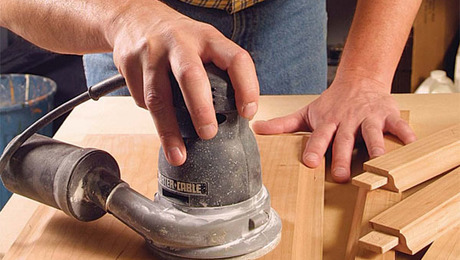 |
Tips For Sanding Basicsby David Sorg |
Question 2:
From Joel Fägerholt, Finland
I work at a factory where we build saunas, and I’ve noticed that black alder has quite nice ray flecks. The rays are narrower than those found in oak but still nice to look at. Do you know of any more species that have these big visible rays, except already mentioned species?
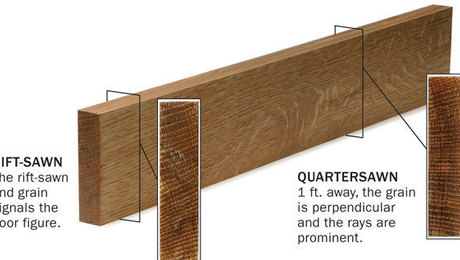 |
Understanding Quartersawn Figureby Kevin Rodel |
Question 3:
From Joe:
Mike, I’m sure you’ve covered this before however, would explain your process for fuming white oak and if this process will get me close to the color of “English Brown Oak” without imparting any dyes or stains. I’m actually building one of your cabinets (yes from your book;) and I’d like just the drawer front to take on that dark brown appearance. What I’m afraid of is if I use a dye or stain, when I go to plane the sides to fit the drawer opening, I may lose some of that color on the end grain of the pin board/drawer front. So, I thought ammonia fuming might be the ticket. And just for clarification, I tried to find some brown oak and struck out.
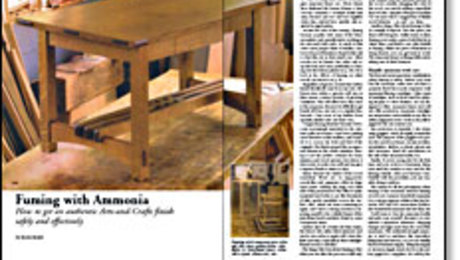 |
Fuming with Ammoniaby Kevin Rodel |
Question 4:
From Drew:
I have always heard that baltic birch plywood is best for shop jigs. However, every time that I pick up a sheet I find that it is not as flat as I would like (for use as a base in a crosscut sled for example). I’ve noticed that MDF is much flatter, but it comes with its own weight and durability issues. What material do you suggest? Do you employ construction methods to keep your base flat? Am I worried too much about flatness?
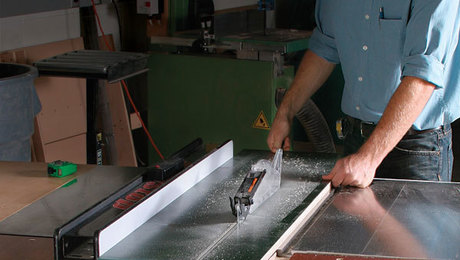 |
The Ultimate Shop Plywoodby Stuart Lipp |
Segment: Shop resolutions
Ben – Finally get some drawers in his shop!
Tom – Build some hanging tool storage for the walls of his shop.
 |
Hand tools are kept close at hand with hanging panelsby Jason Stephens |
Mike – Finally change the lightbulbs in his shop.
Question 5:
From Dean:
As previously disclosed I am outfitting an auxiliary shop and the question of sharpening arises. I am a fan of waterstones. I have a lab sink in my south shop and am accustomed to flattening waterstones with a diamond lapping plate under running water. The north shop is heated and no challenge keeping stones hydrated in a tub. But, how do I flatten stones without running water? Others certainly have the same problem—I just never contemplated another waterless flattening methodology. Suggestions or commentary is appreciated.
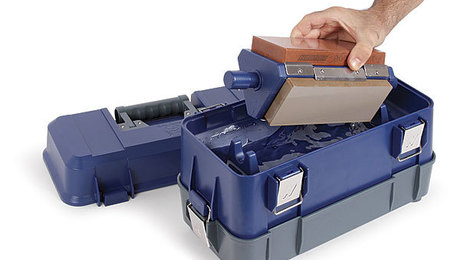 |
Question 6:
From Mat in Australia:
I see many people pushing their re sawn piece towards the fence beyond the blade. Surely this closes the kerf and pinches the blade. Is this a problem? I try not to do this but at times it would be useful to provide some sideways pressure towards the fence to keep to the line.
Question 7:
From Jesse:
I’m new to woodworking and slowly outfitting my small workshop. I’m limited on space, but I’d like to get a jointer to reap the economic advantages of rough sawn lumber. Are 6” benchtop jointers worth the money? Should I be worried about the aluminum fence that most of these have? Is the table length a concern? Am I better off buying a used, floor-standing jointer with a mobile base and sacrificing space?
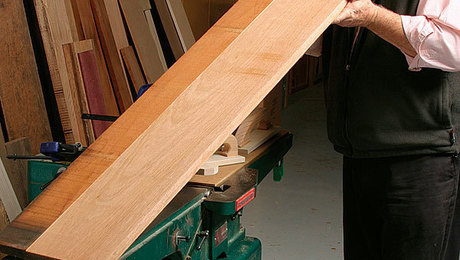 |
Question 8:
From Cramer:
Long time listener / third time questioner. I’m thinking about getting a good track saw – either the Festool 55 or Makita (per the article in FWW 255) – to do, among other things, 45deg miters in 3/4″ or 1″ baltic birch plywood for an open-front cabinet (roughly 24″ w x 36″ h x18″ d). Being as careful as possible with the setup and cut, could I expect this joint to come together cleanly? From all the reviews it sounds like these saws are great and 90deg cuts are perfect, but how are they at creating mating 45s? I could take a trip and do this on a good table saw, but would like to be able to do it in my own shop (#newtoolexcuses).
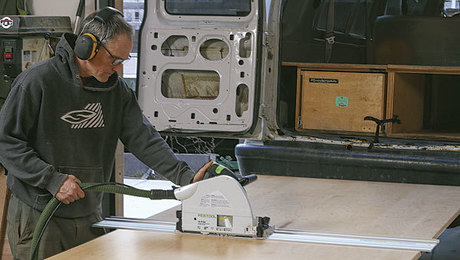 |
Track Sawsby Mark Edmundson |
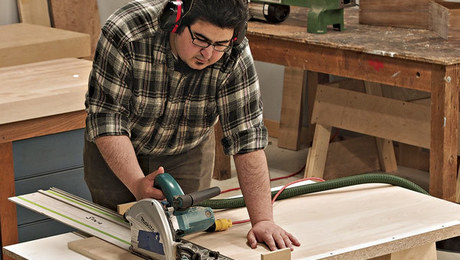 |
Question 9:
From Aaron:
The past few weeks I have been working on a Walnut crib (my first child is due in October). I wanted to lighten the tones of the Walnut to give a more classic color to better match the design of the bed. I am using a coat of Amber shellac for color, followed by a sprayed lacquer for protection. While applying the shellac, I quickly realized an issue. There are areas of sapwood on focal visual points of the bed. While the rest of the Walnut turns a beautiful medium brown, the sapwood turns, well, orange. I want to know if there is any way to avoid this or another finish that will yield similar color without the orange staining, Should have just better selected my lumber to avoid any and all sapwood.
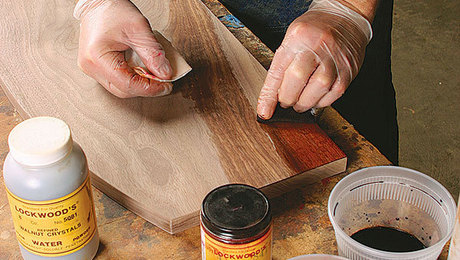 |
Concealing Sapwoodby Peter Gedrys |
Every two weeks, a team of Fine Woodworking staffers answers questions from readers on Shop Talk Live, Fine Woodworking‘s biweekly podcast. Send your woodworking questions to [email protected] for consideration in the regular broadcast! Our continued existence relies upon listener support. So if you enjoy the show, be sure to leave us a five-star rating and maybe even a nice comment on our iTunes page.






















Comments
Excellent podcast guys - tons of helpful advice and useful solutions to common problems! Nice to see you giving Kevin Rodel a shoutout. I truly enjoyed a few of his past video workshop projects, he has a wonderful methodology and pace to his teaching.
Enjoyable conversation to eavesdrop on, as always.
Ben, if you want to keep your resolution of building drawers, you should consider getting the Porter Cable dovetail jig. It's inexpensive and makes short work of drawers. I banged out 12 drawers of varying depths in only 3 weekends -- and I'm a novice!
And I might add that only about 2 weeks ago I bought a Rikon benchtop jointer -- Ouch!
Pocket hole screws and brad nails... they're done and filled with tools already!
Ben, a suggestion for your 8/4 offcuts. I have made two of these tables. The top is about 9”x 12” (small living room) and the legs are a little narrower than 1.5”. The pegs are from an ebony pen blank
One of my all time favorite lines comes from Tom at 35:20 into the session: "The more time I spend in my shop, the more I realize that things aren't as they should be."
One more great reason to spend time out there.
Log in or create an account to post a comment.
Sign up Log in